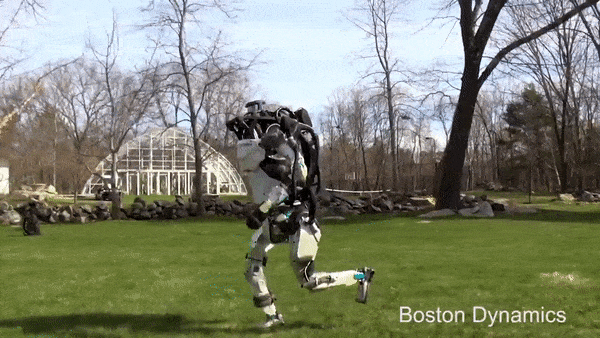Watch Out: This Robot Could Run After You

You can run from Boston Dynamics' humanoid robot Atlas, but it wouldn't do you any good — the robot can run after you.
In a video shared to YouTube yesterday (May 10) by the robot maker, the uncannily human-like Atlas demonstrates running ability that is eerily reminiscent of a person's. The robot jogs methodically across an expanse of grass, against a backdrop of trees punctuated by a few isolated buildings.
The scene is almost peaceful and idyllic, except for the pervasive whirring and clanking of Atlas' motors, gears and joints, and the sense of growing unease that comes with witnessing the inexorable approach of our future robot overlords. [Super-Intelligent Machines: 7 Robotic Futures]
Boston Dynamics poses the video's title as a question — "Getting some air, Atlas?" — as though Atlas had somehow unexpectedly taken himself outside for a run, on a whim.
The robot, described as "the world's most dynamic humanoid" on the Boston Dynamics website, runs at a slow-but-steady pace over grass, up a slight incline to another field, and then stops in front of a log. Atlas steadies himself, bends his "knees," raises his "arms" and nimbly hops over the log, landing without a wobble. It's an impressive display — and so much like the actions of a person that it's also a little unsettling.
This isn't the first time that Atlas' antics have gone viral. Atlas appeared in a video compilation posted to YouTube on Feb. 23, 2016, that showed the robot walking flat-footed through a snow-covered forest, stacking boxes on shelves and recovering its balance after a Boston Dynamics employee pushed the bot with a hockey stick.
Another video, released on Nov. 16, 2017, showed Atlas hopping on and off blocks and even performing a backflip.
Get the world’s most fascinating discoveries delivered straight to your inbox.
But this is the first footage to show Atlas "free running" outdoors. This new video may represent a test of the robot's balance and ability to navigate in a landscape that is more uneven than a warehouse floor, as the robot's sensors are intended to allow it to move smoothly over "rough terrain" and to quickly recover if it stumbles or falls over, according to the Boston Dynamics website.
Original article on Live Science.

Mindy Weisberger is a science journalist and author of "Rise of the Zombie Bugs: The Surprising Science of Parasitic Mind-Control" (Hopkins Press). She formerly edited for Scholastic and was a channel editor and senior writer for Live Science. She has reported on general science, covering climate change, paleontology, biology and space. Mindy studied film at Columbia University; prior to LS, she produced, wrote and directed media for the American Museum of Natural History in NYC. Her videos about dinosaurs, astrophysics, biodiversity and evolution appear in museums and science centers worldwide, earning awards such as the CINE Golden Eagle and the Communicator Award of Excellence. Her writing has also appeared in Scientific American, The Washington Post, How It Works Magazine and CNN.


